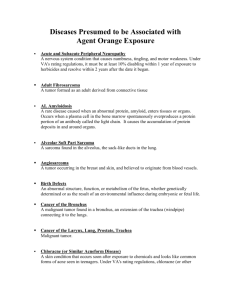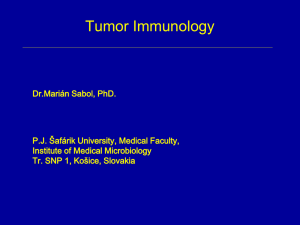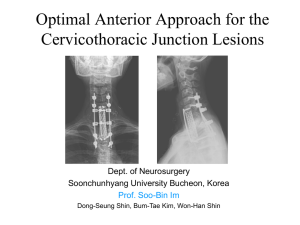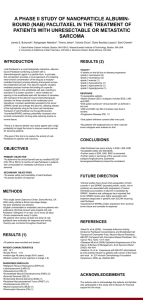Case Study 93 - Division of Neuropathology
advertisement
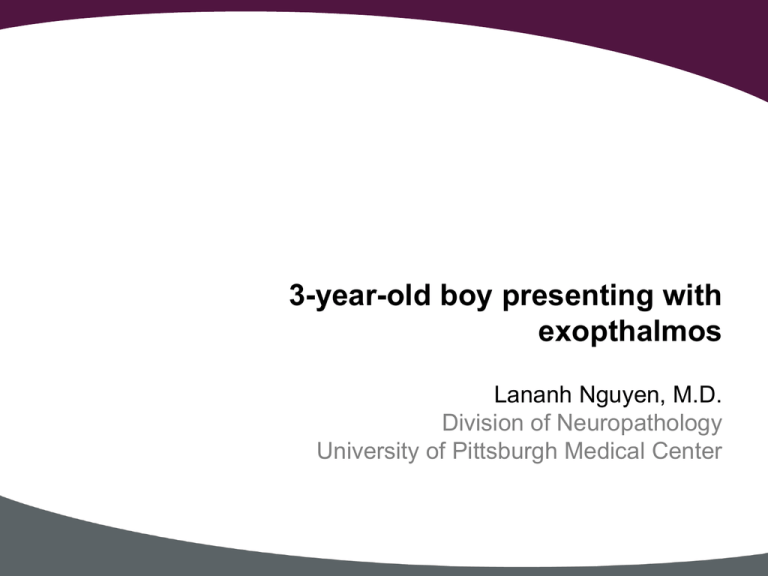
3-year-old boy presenting with exopthalmos Lananh Nguyen, M.D. Division of Neuropathology University of Pittsburgh Medical Center Clinical history • Patient presented to the PCP complaining of right eye swelling. Given the patient’s history of allergies, antihistamines were prescribed without improvement. • A few weeks afterwards, patient presented to the ED with right eye protrusion and erythema. • Physical exam showed intact vision. • And imaging was performed. 2 Radiology: Identify the lesion and name the 3 imaging modalities used below. 3 Radiology: Imaging of the skull lesion. Identify the lesion and name the 3 imaging modalities used below. T1 T1 with contrast T2 This is an extraaxial (nonbrain) mesenchymal lesion invading into the orbital space 4 A biopsy was performed and an intraoperative consultation was requested. Click on the link for the whole slide image of the smear , scan the virtual slide and try to formulated a differential diagnosis. 5 A biopsy was performed and an intraoperative consultation was requested. What do you see on the smear? Low power 6 A biopsy was performed and an intraoperative consultation was requested. What do you see on the smear? Low power It is lesional and abnormally hypercellular 7 High power smear. What do you see on the smear? Benign or malignant? High power 8 High power smear. What do you see on the smear? Benign or malignant? High power Small blue cells 9 Mitosis These are the permanent H&E slides. 10 These are permanent H&E slides. High power 11 Is it benign or malignant? 12 Is it benign or malignant? • Malignant 13 What is your differential diagnosis? 14 What is your differential diagnosis? • Small round blue cell tumor – – – – – – – 15 Ewings Sarcoma/ Primitive neuroectodermal tumor Neuroblastoma Rhabdomyosarcoma CNS Primitive neuroectodermal tumor Lymphoma Atypical teratoid rhabdoid tumor Ependymoma What stains would you order? 16 These are the stains the pathologist ordered. – Ewings Sarcoma/ Primitive neuroectodermal tumor – CD99 – Neuroblastoma – Pgp 9.5, synaptophysin or chromogranin – Rhabdomyosarcoma – myogenin, desmin, smooth muscle actin, vimentin – CNS Primitive neuroectodermal tumor – GFAP – Lymphoma – CD3, CD20 – Atypical teratoid rhabdoid tumor – INI – Ependymoma – EMA, p53 17 Immunohistochemical stains CD99 18 Immunohistochemical stains synaptophysin 19 What do you see on the stains? • CD99 was strongly and diffusely positive • Synaptophysin showed diffuse but patchy cytoplasmic staining • Vimentin (not shown) highlighted vessels • INI (not shown) was intact • All other stains (not shown) in panel were negative 20 What is your final diagnosis? 21 What is your final diagnosis? • Final diagnosis: – Ewings Sarcoma/Primitive Neuroectodermal tumor – FISH studies were positive for t(11;22). 22 Discussion Many translocations have been identified for Ewing’s sarcoma. The table lists the most commonly identified ones with t(11;22) as the most common. Adapted from 23 Discussion • The prognostic factors for increased survival and response to treatment are: – – – – – – – – Female gender Younger children (<10 years old) Small tumor size or volume Tumor location (axial worse than extremities) Decreased serum lactate dehydrogenase (LDH) No metastasis Lack of overexpression of p53 Low Ki67 proliferation index • The 5-year survival rate has increased over the same time from 59% to 76% for children younger than 15 years and from 20% to 49% for adolescents aged 15 to 19 years.[Smith MA, Seibel NL, Altekruse SF, et al.: Outcomes for children and adolescents with cancer: challenges for the twenty-first century. J Clin Oncol 28 (15): 2625-34, 2010.] 24






